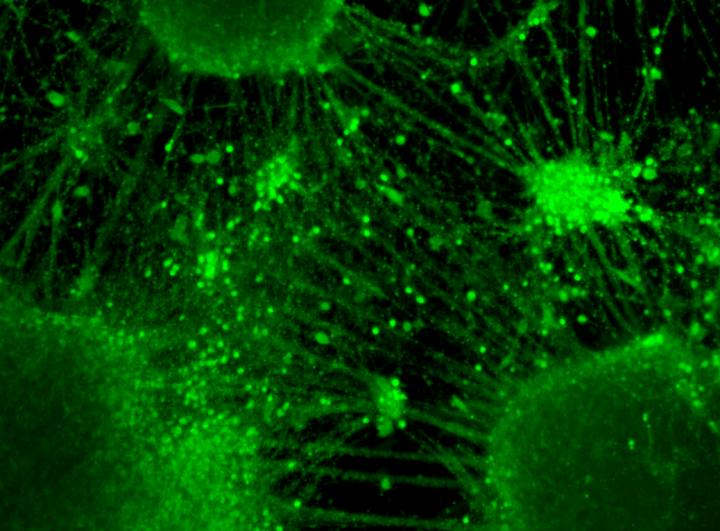
Credit: Takahashi et. al / Stem Cell Reports
Cerebral organoids are artificially grown, 3D tissue cultures that resemble the human brain. Now, researchers from Japan report functional neural networks derived from these organoids in a study publishing June 27 in the journal Stem Cell Reports. Although the organoids aren’t actually “thinking,” the researchers’ new tool – which detects neural activity using organoids – could provide a method for understanding human brain function.
“Because they can mimic cerebral development, cerebral organoids can be used as a substitute for the human brain to study complex developmental and neurological disorders,” says corresponding author Jun Takahashi, a professor at Kyoto University.
However, these studies are challenging, because current cerebral organoids lack desirable supporting structures, such as blood vessels and surrounding tissues, Takahashi says. Since researchers have a limited ability to assess the organoids’ neural activities, it has also been difficult to comprehensively evaluate the function of neuronal networks.
“In our study, we created a new functional analysis tool to assess the comprehensive dynamic change of network activity in a detected field, which reflected the activities of over 1,000 cells,” says first and co-corresponding author Hideya Sakaguchi, a postdoctoral fellow at Kyoto University (currently at Salk Institute). “The exciting thing about this study is that we were able to detect dynamic changes in the calcium ion activity and visualize comprehensive cell activities.”
To generate the organoids, Takahashi, Sakaguchi, and their team created a ball of pluripotent stem cells that have the potential to differentiate into various body tissues. Then, they placed the cells into a dish filled with culture medium that mimicked the environment necessary for cerebral development. Using the organoids, the team successfully visualized synchronized and non-synchronized activities in networks and connections between individual neurons. The synchronized neural activity can be the basis for various brain functions, including memory.
“We believe that our work introduces the possibility of a broad assessment of human cell-derived neural activity,” Sakaguchi says. The method could help researchers understand processes by which information is encoded in the brain through the activity of specific cell populations, as well as the fundamental mechanisms underlying psychiatric diseases, he says.
While cerebral organoids provide a means for studying the human brain, ethical concerns have been previously raised regarding the neural function of cerebral organoids.
“Because cerebral organoids mimic the developmental process, a concern is that they also have mental activities such as consciousness in the future,” Sakaguchi says. “Some people have referenced the famous ‘brains in a vat’ thought experiment proposed by Hilary Putnam, that brains placed in a vat of life-sustaining liquid with connection to a computer may have the same consciousness as human beings.”
However, Takahashi and Sakaguchi believe that cerebral organoids are unlikely to develop consciousness because they lack input from their surrounding environments.
“Consciousness requires subjective experience, and cerebral organoids without sensory tissues will not have sensory input and motor output,” Sakaguchi says. “However, if cerebral organoids with an input and output system develop consciousness requiring moral consideration, the basic and applied research of these cerebral organoids will become a tremendous ethical challenge.”
In the future, applied organoid research will likely explore three main areas – drug discovery, modelling neuropsychiatric disorders, and regenerative medicine, Takahashi says.
“Cerebral organoids can bring great advances to pharmacological companies by replacing traditional animal models and can also be used to model untreatable neural diseases,” he says. “Using our method, it will be possible to analyze cell activity patterns in brain functions to further explore these areas.”
###
This work was supported by a grant from the Network Program for Realization of Regenerative Medicine from the Japan Agency for Medical Research and Development (AMED), JSPS KAKENHI, and Grant-in-Aid for JSPS Fellows.
Stem Cell Reports, Sakaguchi et al.: “Self-organized synchronous calcium transients in a cultured human neural network derived from cerebral organoids” https://www.cell.com/stem-cell-reports/fulltext/S2213-6711(19)30197-3
Stem Cell Reports, published by Cell Press for the International Society for Stem Cell Research (@ISSCR), is a monthly open-access forum communicating basic discoveries in stem cell research, in addition to translational and clinical studies. The journal focuses on shorter, single-point manuscripts that report original research with conceptual or practical advances that are of broad interest to stem cell biologists and clinicians. Visit http://www.
Media Contact
Annie L. Zhang
[email protected]
Related Journal Article
http://dx.




